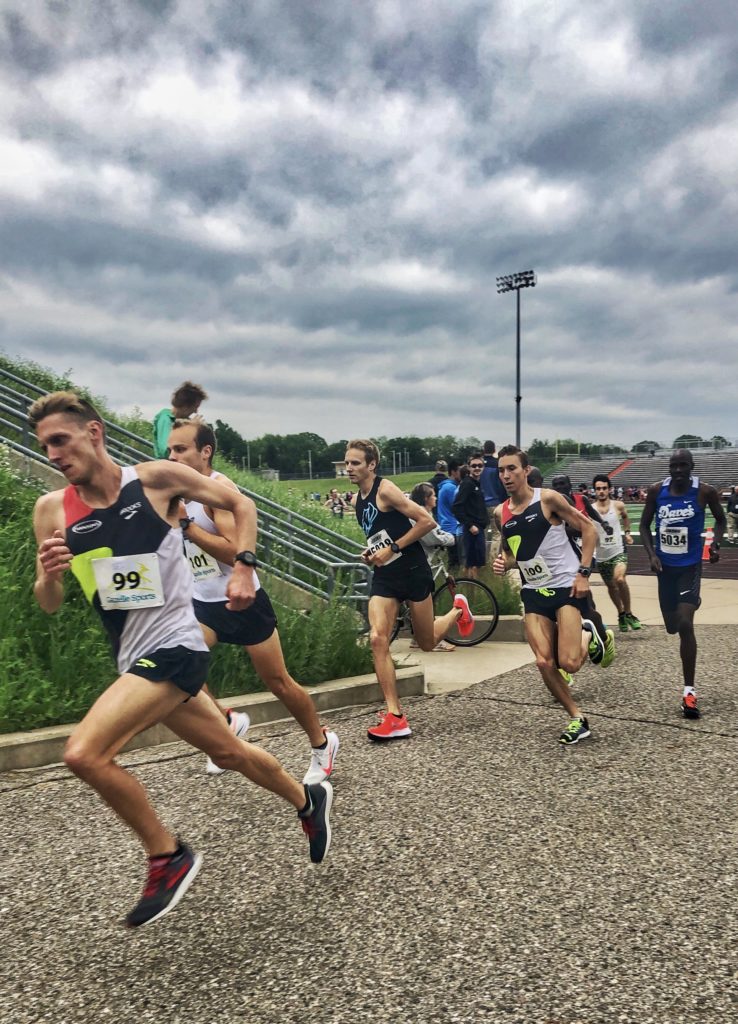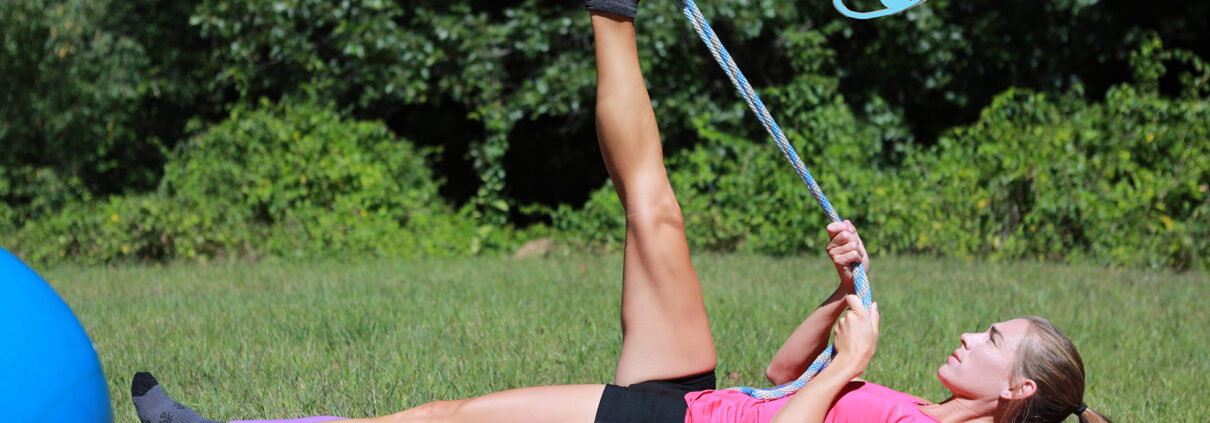The Rule for Recovery (and the LPGA 5k recap!)
How Marathoners Approach 5k Races
Admittedly, the first thing I think when someone says “I’m training for a marathon but want to jump in this 5k. What should I do to prepare?” is not helpful. Because my first thought is: DON’T.
The kind of preparation it takes to be successful in your next marathon and the kind of preparation it takes to be successful in a 5k do not intersect. (Andi interjects here, as she will run a 5k any chance she gets. She loves to race.)
Consider the numbers:
- A marathon is just over 8x longer than a 5k.
- Comparing that to other races, that’s like a mile runner trying to prepare for a 200m dash.
- From a physiological standpoint, your body does not even (for the most part) operate on the same energy systems when running a marathon vs. a 5k.
Therefore, the obvious conclusion is that if your goals lie in the marathon, then don’t look for ways to prepare for a spontaneous 5k.
Now watch me eat my words.
Bad Choices
We have a 3-year-old at home (Miles) who is learning the concept of making bad choices. We find ourselves needing to reinforce the concept constantly. “Hitting your brother is a bad choice, Miles.” or “Dumping your drink on your brother is a bad choice, Miles.” or “Drawing all over your brother is a bad choice, Miles.”
Now that I think about it, maybe the issue is the brother?
Anyway, since I’m a habitual hypocrite, I decided, while in the early stages of a long marathon training cycle, to jump in a local 5k.

In my defense, it was purely benevolent motivation: I was asked to run with one of the teams in the team challenge thing. And sure, I wanted the grocery money (LPGA 5k pays top 3 finishers of EVERY age group in Meijer gift cards).
Were I not myself, I would have told myself to wise up and not run that 5k.
Here’s what I did instead…
Not heeding my own advice, I agreed to run the 5k. But to avert the potential negative impacts of running a hard 5k while knee-deep in a marathon base phase, I did the clever thing to prepare.
I did nothing.
Actually, that’s only true in certain regards. I did not do any workouts or 5k-related runs (remember: laser focus on the big goal – fall marathon). I did, however, conveniently decide to add strides into my weekly routine a few days before the race (I would have done that a week or two later, but that timing was not terribly important in terms of my marathon training).
Five strides two days before the race doesn’t really raise any eyebrows.
But my race day routine might. Not long ago in a comment exchange on one of my Strava runs, Dave DeVries and I bantered about the amount of time it takes us to feel warmed up, be it on an easy run or a race day. The conclusion we both drew was that 5ks are too short and too fast.
Knowing that about myself, I implemented a time-tested technique of running a short tempo run (1.5 miles, in this case) during my warm up before the race. It worked wonders for helping my system ratchet up a few gears so that when we dropped a 4:37 for the first mile, I didn’t feel like someone had lit my legs on fire and forced me to breathe the fumes off them.

Still, after we dropped the same split for the second mile (and the front guys started pushing even more), I knew I had reached my limit. I rumbled the third mile in 4:53 and cruised through the final curve (we started and finished the race on a track) to round out a fairly decent effort, given the circumstances.
The Need for Recovery
Throughout this post, I have clearly articulated my position on unproductive disruptions when training for a particular goal. The 5k, in this example, is exactly that, just like deciding to run 20x400m all-out would be and taking a spontaneous weekend off of running to ride a 300-mile Tour de Pavement would be.
While there is an argument for the positive benefits of a dynamic or blended training approach, in most instances, extreme variations from my primary goal are unproductive.
The predominant reason for this is not that those things will hurt me (although some could, depending on the extremity). The argument, instead, is that those things disrupt my momentum, often by forcing me to spend valuable training days recovering instead of continuing to press forward.

In so many ways, momentum is king in terms of distance training. The more uninterrupted weeks of solid volumes with strong long runs that I can string together, the better my growth in fitness. This is why I am a proponent for rhythm runs and why I feel that most canned training plans get the whole marathon thing totally backward.

That said, my greatest concern surrounding the LPGA 5k was that I would blitz my legs and force myself to take a couple days light and easy to bounce back (that and the fact that I was hoping to still run a long run the next day).
I did not anticipate that I would actually feel pretty solid the next day, allowing me to still log an aggressive long run (that might have been a bit of a mistake as well, but I’m not going to get into that yet).
All of that points to the big takeaway for this post.
The Rule for Recovery
In very clear terms, the rule for recovery is:
In a given effort, the harder you push or deeper you dig, the more time and care your body needs to recover.
I intentionally included the word “care” there because passive recovery rarely is effective and can often be even more problematic for you. I am a strict believer that in most cases, total rest is the worst way to recover from a hard effort (this often excludes things like sickness or end-of-season recovery).
Before I address active rest, though, I want to dwell a moment on the recovery rule. As a training principle, this simply means that I should be keenly aware of how much I am taxing my body with a given effort and whether that aligns with my end goal and current training status.
Here’s my take (and I have touched on this in the past):
- In almost every context, lighter workouts in greater frequency and less recovery is better than harder workouts in lesser frequency and more recovery.
- This is why you will see me generally dismiss things like interval workouts and any kind of anaerobic work for the vast majority of a training cycle (because of the opportunity costs of quality training time lost to recovery and a less beneficial interval workout instead of something like a long tempo run).
- However, it must be stated that all of these things are absolutely situational and are only a small piece of the larger puzzle that is how to get you to the highest degree of fitness possible in time for your target race date. The answer to that is almost never by following some scripted training plan or rigidly implementing some set of training principles and concepts.
Active Recovery
What to do during those recovery periods is just as important as implementing the training principles well, so for the sake of wrapping up this topic neatly, let me share a few proven methods for speeding and aiding recovery.
First, a comment: my perspective is the “do something every day” perspective. The human body craves routine, so if you run Monday, Wednesday, Friday, Saturday at 6am, then at 6am on Sunday, Tuesday, Thursday, still do something.
Here are the good ones:

- Cross-train. It’s never to be underestimated. The key is getting the heart rate high without the pounding of running (for most).
- General Strength and Mobility. Recovery days are the best days for isolating weaknesses or reinforcing the essentials. Core workouts, hip routines, and even a bit of weightlifting all contribute to elevating your body’s ability to put out hard efforts and rebound from them more quickly. Be careful not to overdo things the first week or two of any new routine or exercise. It will always have the reverse effect initially (think of it as its own miniature hard effort when you first add in something new).
- Change in running surface. This one does not get enough credit in adult running circles. Get off the pavement and get on some grass! Just like a GSM routine targets muscle groups not necessarily isolated by running motions, changing the stability of the surface on which you run will shift which muscle groups are putting out the most effort. Grass, trails, or even turf can significantly contribute to your recovery experience.
- Isolated Flexibility and Myofascial Release. In thinking of your body as the machine that it is, never neglect the fine-tuning that though not likely to contribute greatly in isolation, has immeasurable benefit over time. Do your foam rolling, trigger point, graston, static stretching, yoga, etc. And do it regularly. Can’t fit it in every day? Adopt this simple rule: if I don’t do it today, I MUST do it tomorrow. No compromise.
Be Smart and Listen to Your Body
I think that if you are reading this, then you get the listen to your body thing. If it hurts, stop, if you’re tired, rest, etc. However, I want to encourage you to understand the underlying principles better, as well, because as you will agree, just resting when you’re tired may not actually be what your body needs (there’s so much more going on).
Find people who know this stuff well and lean on them. Read the books. The smart ones (my top recommendation is Healthy Intelligent Training, but Daniels’ Running Formula is always a good read).And ultimately, don’t just do the thing because the person or book (or blog) said it. Understand why and what all is at play and make smarter choices. The best part is that there are so many experts on these things who make a living helping people do just that, so you’re likely in good hands!













Early in my training this season, I lifted with my legs way too hard and messed up my whole week of training. Lesson learned! Loved hearing your thoughts about jumping into a 5k during marathon training. I’m jumping into a Sprint tri next weekend during my Ironman training. I’m not doing anything for it. I’m actually doing a 5 hour bike ride followed by a 30 minute brick run the day before lol. That is a do-not-miss workout. Low expectations for my sprint race time the next day. Just getting in a workout, practicing transition, practicing with race gear, and enjoying my club teammates ?
All great reasons. The transition piece is definitely an important consideration. Way to get after it! For what it’s worth, I think you are wisely maximizing the opportunity! Always love hearing your thoughts! Looking forward to hearing about your sprint!
This is some awesome tips and information. Love the recap also. I’m not a fast runner by any means, but love to read tips and strengthening exercises that will help in the long run. Thanks again for the blog
Steve, we always appreciate your reactions!
I think I learned early in my running years that while very few of us reach the level of the elites or pros, we can all learn things from what they do. So that’s what we’ve tried to do and will continue to try to share!
It’s fun to hear your brain play out- I like your concepts of “If not today, tomorrow!” and “Do something everyday”. Thanks for sharing Zach
Right on, Melissa! Appreciate the feedback. (Also, thanks for letting Adam come out to LPGA – we know it is tough finding that balance, and especially throwing work in the mix!)
Liked the LPGA 5k Recap. Always great to hear how a race went down honestly and personally. I can imagine some of the thoughts going on upstairs during the race. Possible Thoughts, 1. Couple of these guys are legit! 2. Why the heck did I sign up for this! 3. Meijer Gift Cards!!! 4. I’m Marathon Training! ? You showed up to a local event and mustered out a pretty darn good time considering you haven’t been doing any intervals. For me (slow runner) at least 4-6 weeks of intervals are a must during 5k training for my legs to accept the faster turnover needed for 5k. Consider that a speed workout for the “main goal” Chicago. Well done sir! ?. I honestly think you should race a few more during your training cycle. We won’t judge you if you don’t get free groceries. Although we will judge a top 25 finish in Chicago. Perhaps a weekly track session with your followers (tag team style)? Solid race, solid post, solid runner. Tokyo 2020??
Jam, that’s very supportive of you – thanks! I make no promises, but come August/September, I’ll be looking to start jumping in some races (I’m always a fan of supporting Mitchell’s Run in Rockford, and the timing of Bridge Run in GR is quite perfect for a final tune-up for Chicago!).